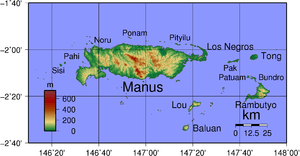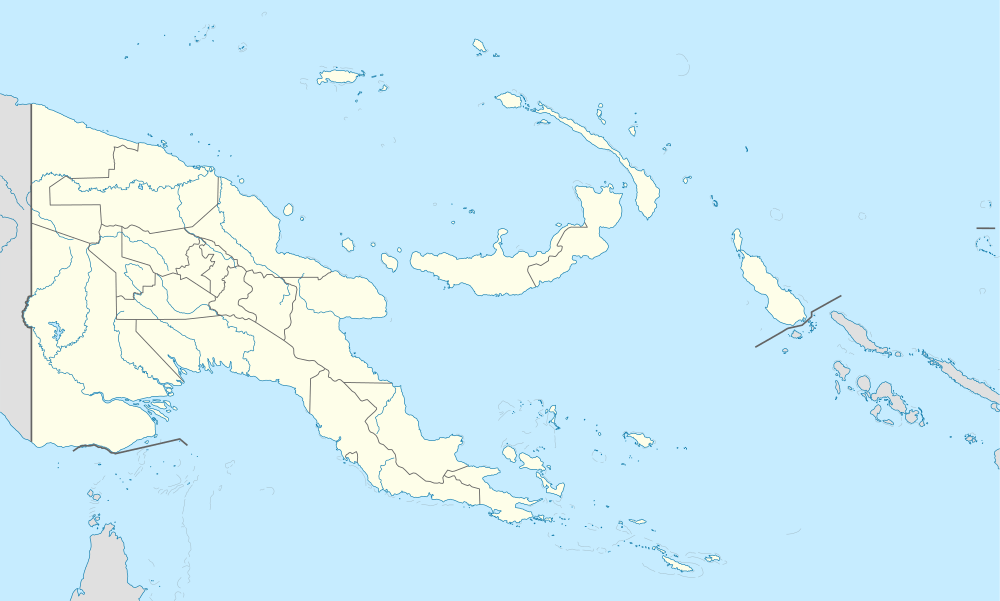Manus Island
Manus Island is part of Manus Province in northern Papua New Guinea and is the largest of the Admiralty Islands. It is the fifth-largest island in Papua New Guinea, with an area of 2,100 km2 (810 sq mi), measuring around 100 km × 30 km (60 mi × 20 mi). Manus Island is covered in rugged jungles which can be broadly described as lowland tropical rain forest. The highest point on Manus Island is Mt. Dremsel, 718 metres (2,356 ft) above sea level at the centre of the south coast. Manus Island is volcanic in origin and probably broke through the ocean's surface in the late Miocene, 8 to 10 million years ago. The substrate of the island is either directly volcanic or from uplifted coral limestone.
 Admiralty Islands | |
 Manus | |
| Geography | |
|---|---|
| Coordinates | 2°5′37.28″S 146°58′17.33″E |
| Archipelago | Admiralty Islands |
| Area | 2,100 km2 (810 sq mi) |
| Length | 100 km (60 mi) |
| Width | 30 km (19 mi) |
| Highest elevation | 718 m (2,356 ft) |
| Highest point | Mt. Dremsel |
| Administration | |
Papua New Guinea (PNG) | |
| Province | Manus Province |
| Largest settlement | Lorengau (pop. 5,829) |
| Demographics | |
| Population | 50,321 (province)[1] (2011) |
Lorengau, the capital of Manus Province, is located on the island. Momote Airport, the terminal for Manus Province, is located on nearby Los Negros Island. A bridge connects Los Negros Island to Manus Island and the province capital of Lorengau. In the 2000 census, the whole Manus Province had a population of 50,321. The Austronesian Manus languages are spoken on the island.
The Australian-run Manus Regional Processing Centre was situated on Los Negros Island from 2001 to 2017, to house asylum seekers arriving by boat found within Australia's defined territorial borders.
Manus Island is home to the emerald green snail, whose shells were harvested to be sold as jewellery; this continues, albeit at a lesser scale, as due to the snail's status as a threatened species, its sale for this purpose is now illegal in many jurisdictions.
History
The first recorded sighting of Manus Island by Europeans was by Spanish explorer Álvaro de Saavedra on board the carrack Florida on 15 August 1528, while trying to return to New Spain from the Maluku Islands. Saavedra circled Manus Island, and landed possibly on Murai islet to the south west. Murai was found to be inhabited and some natives came out in canoes, attacking with bows and arrows. Three of these men were captured by the Spaniards, and were returned by Saavedra to the same island, on his second attempt to return to North America the following year. Manus Island was charted as Urays la Grande or Big Urays, which is probably a projection of Murai to signify "big Murai".[2]
In World War II Manus Island was the site of an observation post manned by No. 4 Section, 'B' Platoon, 1st Independent Company, Australian Imperial Force,[3] who also provided medical treatment to the inhabitants.[4] Manus was first bombed by the Japanese on 25 January 1942, the radio mast being the main target.[3] On 8 April 1942 an Imperial Japanese force consisting of the light cruiser Tatsuta, destroyer Mutsuki and a troop transport ship Mishima Maru entered Lorengau harbour and several hundred Japanese soldiers of the 8th Special Base Force swarmed ashore onto the Australian-mandated island. The vastly outnumbered Australians withdrew into the jungle.[3]
Later in 1942, Japan established a military base on Manus Island. This was attacked by United States forces in the Admiralty Islands campaign of February – March 1944.[5] An Allied naval base was established at Seeadler Harbor on the island and it later supported the British Pacific Fleet. The ammunition ship USS Mount Hood exploded in Seeadler Harbor on 10 November 1944 with a heavy loss of life of US Navy personnel.
In 1950–51 the Australian government conducted the last trials against Japanese war criminals on the island.[6] One case heard was that of Takuma Nishimura, who faced an Australian military court. He had already been tried by a British military court in relation to the Sook Ching massacre in Singapore and sentenced to life imprisonment. While on a stopover in Hong Kong he was intercepted by Australian Military Police. Evidence was presented stating that Nishimura had ordered the shootings of wounded Australian and Indian soldiers at Parit Sulong and the disposal of bodies so that there was no trace of evidence. In this trial he was found guilty and was hanged on 11 June 1951.
American anthropologist Margaret Mead lived on Manus Island before and after the war, and gave detailed accounts in Growing up in New Guinea and New Lives for Old.
Detention centre
In addition to its resident population, asylum seekers have been located on Los Negros between 2001 and 2004 and since 2012.[7][8]
Australia set up the Manus Regional Processing Centre on Manus Island in 2001 as part of its Pacific Solution. In August 2012, the Australian Government controversially[9] announced it would resume offshore processing; in November 2012 the relocation of asylum-seekers to Manus Island resumed.[10]
On 26 April 2016, the Supreme Court of Papua New Guinea ruled that the detention of asylum seekers on Manus Island was illegal,[11] and Prime Minister Peter O'Neill announced that the centre would be closed.[12] After a stand-off involving PNG military and police, all remaining men were removed to new accommodation at the East Lorengau Refugee Transit Centre, Hillside Haus and West Lorengau Haus[13] by 23 November 2017.[14][15]
In late 2019, the remaining asylum seekers were moved to Port Moresby, and upon request by the PNG government, the Australian Government terminated the contracts of the service providers for the detention centre and other facilities as of 30 November 2019.[16]
Naval bases
On September 20, 2018, The Australian reported that Australia and Papua New Guinea were discussing providing port facilities to the Royal Australian Navy and US Navy on Manus Island.[17] Australia and the United States would help expand Lombrum Naval Base, so there would be facilities for Australian naval vessels there.[18] The newspaper reported that Australia was countering interest China had placed in expanding Papua New Guinea's port facilities at Wewak, Kikori, Vanimo and Manus Island. Manus Island is the most important of these four ports, as it is a deep-water port near important shipping lanes. The RAN operated a naval base on Manus Island from the 1950s until transferred to the Papua New Guinea Defence Force in 1974.[19]
References
- "Papua New Guinea". citypopulation.de.
- Sharp, Andrew (1960). The discovery of the Pacific Islands. Oxford: Clarendon Press. pp. 19, 20.
- Klemen, L (1999–2000). "Manus Island, experience of No. 4 Section, 'B' Platoon, First Independent Company, Australian Imperial Force". Forgotten Campaign: The Dutch East Indies Campaign 1941-1942.
- Klemen, L (1999–2000). "Medical Patrol on Manus Island, 1941". Forgotten Campaign: The Dutch East Indies Campaign 1941-1942.
- Video: Americans Win New Airbases In South Pacific Etc. (1944). Universal Newsreel. 1944. Retrieved 21 February 2012.
- Piccigallo, Philip; The Japanese on Trial; Austin 1979; ISBN 0-292-78033-8, ch.: "Australia".
- Matt Siegel: "Australia Adopts Tough Measures to Curb Asylum Seekers", in The New York Times, 19 July 2013
- Refuge prisons in Manus Roger Cohen, NYTimes, December 9, 2016
- "United Nations rejects Australia's off-shore processing plans - Asia Pacific". radioaustralia.net.au.
- "Subscribe - theaustralian". www.theaustralian.com.au.
- "Papua New Guinea's Supreme Court rules detention of asylum seekers on Manus Island is illegal". ABC News. Australian Broadcasting Corporation. Retrieved 26 April 2016.
- Stephanie Anderson (27 April 2016). "Manus Island detention centre to be shut, Papua New Guinea Prime Minister Peter O'Neill says". ABC News. Australian Broadcasting Corporation. Retrieved 10 January 2018.
- Fox, Liam; Yaxley, Louise (1 November 2017). "PNG army prepares to enter Manus Island centre, 600 men still inside". ABC News. Retrieved 1 November 2017.
- Baxendale, Rachel. "Manus Island: last of asylum seekers removed from detention centre". www.theaustralian.com.au. News Limited. Retrieved 30 November 2017.
- Davidson, Helen; Wahlquist, Calla (31 October 2017). "Power shut off to final Manus compounds as 600 men refuse to leave". British Broadcasting Corporation – via www.theguardian.com.
- Australian Government. Senate. Legal And Constitutional Affairs Legislation Committee (21 October 2019). "Estimates": 50. Retrieved 21 November 2019.
Proof Committee Hansard
Cite journal requires|journal=(help) -
"Move to head off China with Australian base in PNG". The Australian. 20 September 2018. Retrieved 20 September 2018.
Australian officials have expressed concerns over Chinese interest in the redevelopment of four PNG ports, at Wewak, Kikori, Vanimo and Manus Island, fearing the Asian superpower is working towards gaining a military foothold in the region.
- Dziedzic, Stephen (17 November 2018). "US to partner with Australia and PNG on Manus Island naval base". ABC News. Retrieved 15 June 2019.
- Moore, John, ed. (1977). Jane's Fighting Ships 1977–78. Jane's Fighting Ships (80th ed.). London: Jane's Yearbooks. p. 20. ISBN 0531032779. OCLC 18207174.